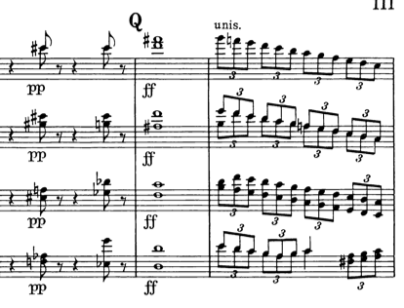Programmatic Symphonies consist of literally a ‘program’ and a ‘symphony’ – the program being the story and the symphony being the medium in which the story is conveyed. (WordPress, 2011) Programmatic symphonies differ from symphonic poems in the fact that they are longer, and consist of multiple movements rather than just one. Keeping this in mind, we’re going to be looking at the most important parts of a many program symphonies rather than analysing an entire work because damn that would take a buttload of time which i don’t have because it’s currently Thursday and I still have two more assignments to do 😛
The ‘first’ programmatic symphony was composed by Beethoven in 1808. Symphony no. 6 is considered a programmatic symphony because it aims to paint a picture of a calm countryside by a brook using instrumentation instead of words or visual cues. Beethoven even went as far as to label the instruments as the character or scenery they were meant to be portraying on the score e.g. the flutes were labelled as nightingale, the oboe quail, and the clarinets were cuckoo birds. (WordPress, 2011)
Another example of a program symphony is Berlioz’s “Symphonie Fantastique” entitled “‘Episodes in the life of an artist”. “Each movement describes a different scene, for instance the second a scene at a ball, the third a scene in the country and the fourth the ’March to the scaffold’.” (Education Scotland, 2011) In ‘March to the Scaffold’, there are many points where you can clearly hear what is happening in the scene, including the footsteps up to the guillotine, the tender last words to his loving family (played by clarinet, using it’s warm timbre to convey the emotion) then finally the fall of the guillotine and the bounce of his head falling from the scaffold.
Mahler, a late composer in the Romantic period, used program symphonies not to describe a physical scene but rather to explore human emotions. This concept really brought about the idea of expressionist music and was most developed during the 20th and 21st centuries. In Mahler’s Symphony no. 2, he explores the idea of life and death and uses the program symphony to strengthen these ideas.
“The first movement illustrate a funeral; the second movement recalls the happy times in the life of the deceased; the third movement presents the meaninglessness of life; and the fourth movement suggests the wish for the release from the meaninglessness of life. In the fifth and final movement, Mahler calls for the fervent hope for transcendental renewal.” (WordPress, 2011)
Mahler made the finale much more expression and hope. For example, in the chorus part Mahler indicated to sing “Mit hochter Kraft” (with highest power); and he even brought his own church bells to the performance, not trusting those provided by the church to have the correct sound. Using Mahler’s symphony as an example, we can see that the programmatic symphonies are more versatile than we think, and can be used to not only tell a story, but also to illustrate philosophies.
References
Education Scotland, (2011). Programme music – Symphony – Home page of Learn Listening online. [online] Educationscotland.gov.uk. Available at: http://www.educationscotland.gov.uk/learnlisteningonline/higherandadvancedhigher/musicaltopics/symphony/programmemusic.asp [Accessed 23 Apr. 2014].
WordPress, (2011). Discuss the concept of programmatic symphonies.. [online] My Blog. Available at: http://lutheryap.wordpress.com/2011/11/01/discuss-the-concept-of-programmatic-symphonies/ [Accessed 23 Apr. 2014].

Leave a comment